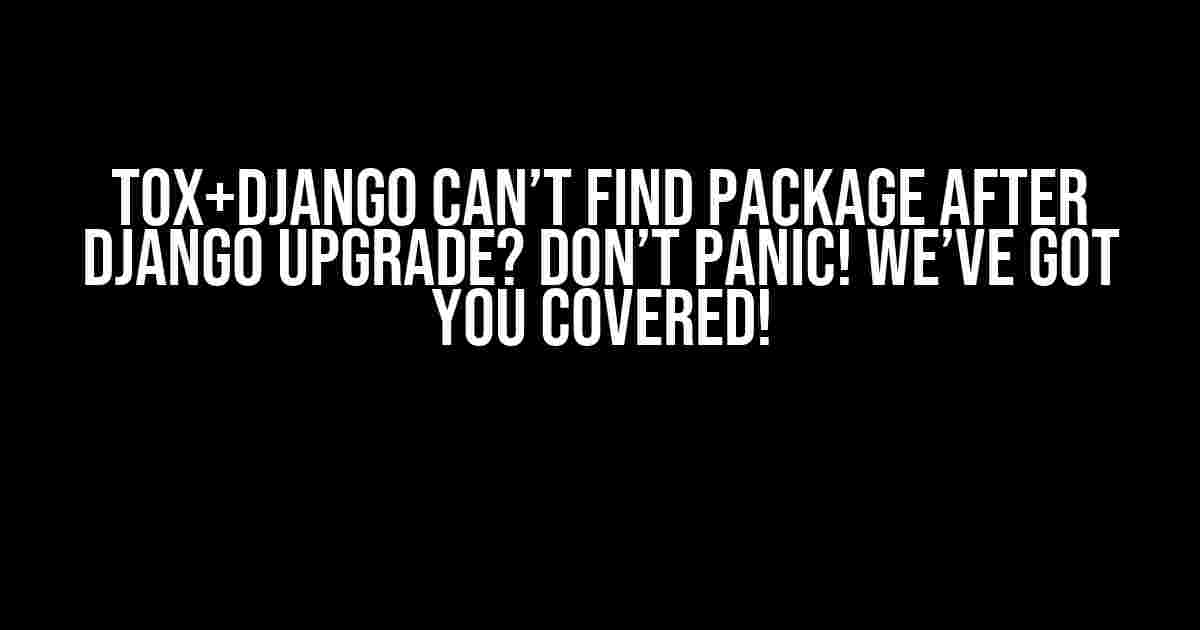If you’re reading this, chances are you’ve recently upgraded your Django project and Tox is throwing a tantrum, refusing to find your packages. Fear not, dear developer! We’re about to embark on a step-by-step journey to solve this pesky issue and get your project back on track.
What’s Going On?
Before we dive into the solution, let’s take a quick peek at what’s causing this drama. When you upgrade Django, it’s not uncommon for Tox to lose track of your package dependencies. This is because Tox relies on Django’s internal package management system, which can get confused during the upgrade process.
Identify the Culprits
Take a deep breath and let’s identify the potential culprits behind this issue:
tox.iniconfiguration file: This file might be outdated or pointing to the wrong package locations.- Package dependencies: Perhaps your package dependencies have changed, and Tox doesn’t know how to handle the new versions.
- Django project structure: Your project’s directory structure might have changed during the upgrade, causing Tox to lose track of packages.
Step-by-Step Solution
Don’t worry; we’ll tackle each of these culprits one by one. Follow these steps to get Tox and Django playing nicely again:
Update tox.ini
First, let’s update your tox.ini file to reflect the changes in your Django project:
[tox]
envlist = py37,py38
[testenv]
commands =
python -m pip install -r requirements.txt
python manage.py test
Make sure to adjust the `envlist` to match the Python versions you’re using. Also, update the `commands` section to reflect any changes in your testing workflow.
Reinstall Packages
Next, we’ll reinstall your package dependencies to ensure Tox has the correct versions:
pip uninstall -r requirements.txt pip install -r requirements.txt
This will remove and reinstall all packages listed in your requirements.txt file.
Update Package Dependencies
If you’ve updated your package dependencies during the Django upgrade, make sure to update your requirements.txt file accordingly:
pip freeze > requirements.txt
This will regenerate your requirements.txt file with the latest package versions.
Check Django Project Structure
Verify that your Django project structure hasn’t changed during the upgrade:
| Directory | Description |
|---|---|
myproject/ |
Root directory of your Django project |
myapp/ |
Directory for your Django app |
tests/ |
Directory for your test files |
If your project structure has changed, update your tox.ini file to reflect the new directory layout.
Rerun Tox
Finally, rerun Tox to ensure everything is working as expected:
tox
If Tox is still throwing errors, double-check your tox.ini file, package dependencies, and Django project structure for any typos or inconsistencies.
Bonus Tips and Troubleshooting
If you’re still experiencing issues, here are some additional tips to help you troubleshoot:
- Try running Tox with the
--pdbflag to enable the Python debugger:tox --pdb
This can help you identify the exact issue and provide more detailed error messages.
- Verify that your Python versions are correctly installed and configured:
python --version python -m pip --version
Ensure that you’re using the correct Python versions and packages for your project.
- Check your Django project’s
settings.pyfile for any package-related configurations:INSTALLED_APPS = [ # ... 'myapp', # ... ]Verify that your app is correctly installed and configured in your Django project.
Conclusion
And there you have it! With these steps, you should be able to resolve the “Tox+Django can’t find package after Django upgrade” issue. Remember to take your time, be patient, and methodically troubleshoot each potential culprit.
If you’re still stuck, don’t hesitate to reach out to the Django and Tox communities for further assistance. Happy coding, and may the test gods be with you!
Keywords: Tox, Django, package dependencies, upgrade, troubleshooting, testing, Python, Django project structure.
Frequently Asked Question
Get the inside scoop on troubleshooting Tox+Django issues after a Django upgrade
I upgraded Django and now Tox can’t find my package. What’s going on?
Don’t panic! After a Django upgrade, it’s not uncommon for Tox to lose track of your package. Try running `pip install -e .` in your project directory to reinstall your package in editable mode. This should allow Tox to find your package again.
I’ve tried reinstalling my package, but Tox still can’t find it. What’s my next step?
Okay, let’s dig deeper! Check if your `tox.ini` file is pointing to the correct Python version and package location. Make sure the `python` directive in `tox.ini` matches the Python version used in your `venv` or virtual environment. Also, verify that your package is installed in the correct location by running `pip show `.
I’ve checked my tox.ini file, but the issue persists. Could it be related to my Django project structure?
That’s a great point! Sometimes, Tox can get confused if your Django project structure has changed. Try running `python setup.py sdist` to recreate your package distribution, and then run `tox` again. If you’re using a `requirements.txt` file, ensure it’s up-to-date and includes all necessary packages.
My package is installed, but Tox is still complaining about missing dependencies. What’s going on?
Don’t worry, we’re almost there! Tox might be picking up leftover dependencies from previous runs. Try running `tox –recreate` to force Tox to recreate the virtual environment from scratch. This should resolve any dependency issues.
I’ve tried everything, but Tox still can’t find my package. Any last resort solutions?
If all else fails, you can try deleting your `tox` directory and running `tox` again from scratch. This will force Tox to recreate the environment and package cache from the beginning. As a last resort, you can also try reinstalling Tox itself using `pip uninstall tox` and then `pip install tox`.
